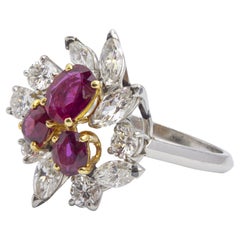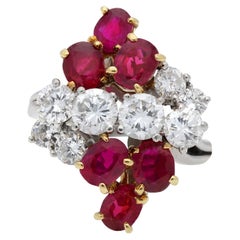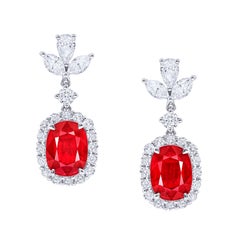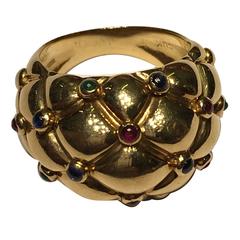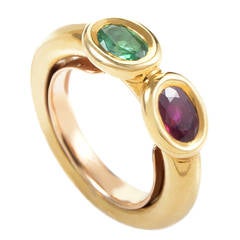Chaumet Ruby Ring
Mid-20th Century French Modernist Cocktail Rings
Diamond, Ruby, Gold, 18k Gold, Yellow Gold, Platinum
2010s Engagement Rings
Diamond, Ruby, Platinum
Vintage 1980s Cocktail Rings
Diamond, Ruby, Platinum
21st Century and Contemporary Dangle Earrings
Ruby
Recent Sales
Vintage 1980s French Modern Dome Rings
Emerald, Ruby, Sapphire, 18k Gold
1990s French Fashion Rings
Emerald, Ruby, 18k Gold, Yellow Gold
Vintage 1970s French Fashion Rings
Ruby, 18k Gold
Late 20th Century French Band Rings
Ruby, 18k Gold
1990s Unknown Retro Dome Rings
Ruby, Gold, 18k Gold, Yellow Gold
20th Century French Band Rings
Ruby, 18k Gold, Yellow Gold
Late 20th Century French Band Rings
Ruby, 18k Gold, Yellow Gold
21st Century and Contemporary French Contemporary Fashion Rings
Diamond, Ruby, 18k Gold
Vintage 1980s Band Rings
Ruby, Sapphire, Blue Sapphire, Gold, 18k Gold, Yellow Gold
21st Century and Contemporary Modern Engagement Rings
Ruby, Sapphire, 18k Gold, Yellow Gold
Late 20th Century French Band Rings
Ruby, 18k Gold, Yellow Gold
Vintage 1980s French Modern Band Rings
Emerald, Ruby, Sapphire, Gold, 18k Gold, Yellow Gold
1990s French Dome Rings
Emerald, Ruby, Sapphire, 18k Gold, Yellow Gold
Early 20th Century Dome Rings
Ruby, 18k Gold
Late 20th Century French Band Rings
Diamond, White Diamond, Ruby, 18k Gold, Yellow Gold
20th Century French Cocktail Rings
Diamond, Emerald, Ruby, 18k Gold
Vintage 1970s French Modern Cocktail Rings
Rubelite, Ruby, Tourmaline, 18k Gold
21st Century and Contemporary French Three-Stone Rings
Diamond, Sapphire, Emerald, Ruby, 18k Gold
20th Century French More Necklaces
Diamond, Emerald, Ruby, Sapphire, 18k Gold
People Also Browsed
21st Century and Contemporary American Contemporary Engagement Rings
Diamond, Sapphire, Blue Sapphire, Platinum
Antique Early 1900s Art Deco Engagement Rings
Diamond, Pink Sapphire, Gold, 18k Gold, Yellow Gold, Platinum
1990s Swiss Wrist Watches
18k Gold, Yellow Gold
20th Century French Retro Clip-on Earrings
Diamond, 18k Gold, Yellow Gold
21st Century and Contemporary American Artist Solitaire Rings
Pink Diamond, Diamond, Platinum
Antique Late 19th Century European Late Victorian Cluster Rings
Diamond, Sapphire, 18k Gold
21st Century and Contemporary American Contemporary Three-Stone Rings
Diamond, White Diamond, Multi-gemstone, Spinel, Platinum
1990s French Evening Dresses and Gowns
Vintage 1970s American Brooches
White Diamond, Turquoise, 18k Gold
Vintage 1910s European Edwardian Engagement Rings
Diamond, Tourmaline, 18k Gold, Platinum
21st Century and Contemporary Choker Necklaces
Diamond
1990s Cocktail Rings
Diamond, Sapphire, Gold, 18k Gold, Yellow Gold
Early 20th Century French Belle Époque More Jewelry
Diamond, Platinum
2010s French Evening Gowns
1990s Italian Evening Bags and Minaudières
Early 20th Century European Edwardian Cluster Rings
Aquamarine, Diamond, Gold, 18k Gold, Platinum
Chaumet Ruby Ring For Sale on 1stDibs
How Much is a Chaumet Ruby Ring?
Chaumet for sale on 1stDibs
Decades before luxury French jewelry maisons such as Van Cleef & Arpels and Cartier were born, Marie-Étienne Nitot (1750–1809) founded the house that became the internationally esteemed Chaumet, which, for centuries, has created timeless necklaces, watches, rings, tiaras and other jewelry and accessories for royalty as well as Hollywood luminaries.
Before opening his own jewelry house, Nitot worked as an apprentice to Ange-Joseph Aubert, court jeweler to Marie Antoinette, and collaborated on pieces for the Queen. In 1780, he left Aubert’s side to open his own maison.
Surviving the upheaval of the French Revolution, Nitot soon found lavish commissions with the new people in power. The Emperor Napoléon Bonaparte longed for France to once again be the epicenter of luxury, making himself the fashionable face of the prospering country. Nitot’s commissions for Napoléon began with the papal tiara for Pope Pius VII that included a 414-carat emerald among its thousands of precious stones and the 1804 coronation sword, a decadent piece that featured the 140-carat Regent diamond.
The young jewelry house soon became the official jeweler of the Imperial Court, the personal jeweler of Empress Joséphine and one of the most sought-after jewelers in Europe. Chaumet’s work in this era helped popularize the tiara as a status symbol, with ornate pieces designed for Joséphine and Empress Marie-Louise, Napoléon’s second wife.
After Nitot died in 1809, his son, François-Regnault, took over in 1812 and moved the maison into the Place Vendôme, making it the first business to occupy the Parisian center of luxury. By then, Chaumet had included timepieces in its offerings, such as bracelet watches adorned with precious gemstones and equipped with movements made by Breguet (which opened a shop on Place Vendôme in 1933).
After the fall of the Napoléon Empire, successors Jean-Baptiste and Jules Fossin focused more on romantic styles of jewelry that referenced the past and nature, an approach carried on by Valentin and Prosper Morel. It was Joseph Chaumet, director from 1885 to 1928, who gave the maison its illustrious name and brought it into the 20th century with jewelry, accessories and tiaras inspired by the extravagant decor of the Belle Époque.
Later, with Joseph’s son, Marcel Chaumet, succeeding him, the house would be featured at the Exposition Internationale des Arts Décoratifs et Industriels Modernes in Paris — from which the term Art Deco derives — and, alongside the likes of Cartier, would be seen as a leader in introducing the flamboyantly geometric designs and high-contrast color pairings of Art Deco jewelry to the global stage.
Chaumet has adapted over the years to meet changing tastes and trends. The house still reigns in the world of luxury jewelry, celebrating its 240th anniversary in 2020. Since 1999, it has been part of the LVMH Group. Its salons and high jewelry workshop continue to operate in the Place Vendôme where gem-setters, polishers and jewelers craft rings, earrings, watches and enduringly popular tiaras.
Find an exquisite range of authentic vintage Chaumet jewelry on 1stDibs.
The Legacy of Ruby in Jewelry Design
This deep red gem is the color of heat and passion — vintage and antique ruby jewelry is perfect for those born in the middle of summer.
Rubies are one of the few gemstones that can give diamonds a run for their money. Just consider the Van Cleef & Arpels “scarf” necklace the Duke of Windsor presented to the Duchess on her 40th birthday, in 1936 — set with diamonds and dripping with rubies, a testament to the deep-red gemstone’s power — or the slippers encrusted with 4,600 rubies that Harry Winston made to commemorate The Wizard of Oz’s golden anniversary. July babies have permission to adorn themselves with this beautiful red stone even when it’s not their birthday.
Rubies are considered precious stones — along with diamonds, sapphires and emeralds — and have a hardness of 9.0 on the Mohs Scale, surpassed only by Moissanite and diamonds. They are composed of corundum, a colorless mineral that is also the basic material of sapphires. In the July birthstone, the red of the gemstone — and the various hues seen in sapphires — are produced by the presence of trace elements. In the case of a ruby, this element is chromium. Rubies range in color from vermilion to a violet red. They are also pleochroic, which means that a stone’s hue can vary depending on the direction of viewing. The most sought-after color is pigeon’s blood: pure red with a hint of blue.
Rubies that are hosted in dolomite marble are the most prized: Because the marble is low in iron, so are the rubies, resulting in a more intense color. Rubies found in basalt, which has a higher iron content, are generally darker and less intense.
When shopping for antique and vintage ruby jewelry, remember that the 4Cs of selecting the perfect diamond — color, clarity, cut and carat — also apply to rubies.
According to the Gemological Institute of America, the color of the July birthstone should be a vibrant to slightly purplish red, and the stone should be clear and inclusion-free. Accordingly, the cut should show off its color and clarity. As for the last criterion, fine rubies more than a carat in weight are rare. Often, large rubies are more expensive than diamonds of comparable weights.
Find a collection of ruby necklaces, ruby rings and other accessories on 1stDibs.
Finding the Right Rings for You
Antique and vintage rings have long held a special place in the hearts of fine jewelry lovers all over the world.
No matter their origin or specific characteristics, rings are timeless, versatile accessories. They’ve carried deep meaning since at least the Middle Ages, when diamond rings symbolized strength and other kinds of rings were worn to signify romantic feelings or to denote an affiliation with a religious order. Rings have also forever been emblematic of eternity.
Over time, rings have frequently taken the form of serpents, which have long been associated with eternal life, health and renewal. Italian luxury jewelry house Bulgari has become famous for its widely loved Serpenti motif, for example, and its Serpenti ring, like the other accessories in the collection, began as an homage to jewelry of the Roman and Hellenistic eras. The serpent is now a popular motif in fine jewelry. Jewelry devotees have long pined for rings adorned with reptiles, thanks to antique Victorian rings — well, specifically, Queen Victoria’s illustrious engagement ring, which took the form of a gold snake set with rubies, diamonds and an emerald (her birthstone). Designs for Victorian-era engagement rings often featured repoussé work and chasing, in which patterns are hammered into the metal.
Engagement rings, which are reliably intimidating to shop for, are still widely recognized as symbols of love and commitment. On 1stDibs, a range of buying guides can be found for those in the market for antique engagement rings, vintage engagement rings or Art Deco engagement rings.
The most collectible antique engagement rings and vintage engagement rings are those from the Victorian, Edwardian and Art Deco eras. Named for the monarchies of the four King Georges, who in succession ruled England starting in 1714 (plus King William’s reign), antique Georgian rings, be they engagement rings or otherwise, are also coveted by collectors. Pearls, along with colored gemstones like garnets, rubies and sapphires, were widely used in Georgian jewelry. The late-1700s paste jewelry was a predecessor to what we now call fashion or costume jewelry.
The Art Nouveau movement (1880–1910) brought with it rings inspired by the natural world. Antique Art Nouveau rings might feature depictions of winged insects and fauna as well as women, who were simultaneously eroticized and romanticized, frequently with long flowing hair. Art Deco jewelry, on the other hand, which originated during the 1920s and ’30s, is by and large “white jewelry.” White metals, primarily platinum, were favored over yellow gold in the design of antique Art Deco rings and other accessories as well as geometric motifs, with women drawn to the era’s dazzling cocktail rings in particular.
Whether you’re hunting down a chunky classic for a Prohibition-themed cocktail party or seeking a clean contemporary design to complement your casual ensemble, find an exquisite collection of antique, new and vintage rings on 1stDibs.
